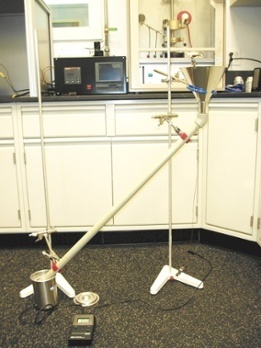The Case for Inductance Testing: Electrostatics and Hazardous Dust
Yet another plant explosion this week reports Powder & Bulk Solids' "Chemical Explodes During Batch Mixing at Ohio Plant" possibly involves electrostatic hazards combining combustible dust and chemicals.
Per Ashok Dastidar, PhD, MBA and Vice President of Dust and Flammability Testing and Consulting Services, Fauske &  Associates, “Electrostatics probably initiated a primary solvent explosion that was then followed by a small dust explosion. The minimum ignition energy levels of solvents are orders of magnitude lower than for dusts. In cases dealing with solvent-dust hybrid situations it is important to understand the Minimum Ignition Energy (MIE) of both the solvent and the dust.”
Associates, “Electrostatics probably initiated a primary solvent explosion that was then followed by a small dust explosion. The minimum ignition energy levels of solvents are orders of magnitude lower than for dusts. In cases dealing with solvent-dust hybrid situations it is important to understand the Minimum Ignition Energy (MIE) of both the solvent and the dust.”
Gaining an understanding of the electrostatic characteristics of a particular material can greatly assist in the assessment and mitigation of fire and explosion hazards in the process environment. By utilizing data, it is possible to minimize risk by implementing proper grounding and bonding of process equipment. Data also provides clues on how to adjust process parameters to reduce charge build up and ultimately help work toward creating a safe work environment.
"In a recent discussion regarding NFPA regulations, I noted that we encouraged a food processing plant customer who regularly had us test materials with inductance to also test without inductance" states Dastidar. "Inductance allows you to test for real processing conditions where electrical/electronic ignition sources are present and without inductance simulates static electrical sparks such as those that occur while batch mixing."
Identifying the electrostatic characteristics of a material is an important step when evaluating the hazards associated with a process, especially for those handling materials that exhibit low ignition energies. Charge separation and accumulation are inherent problems resulting from industrial operations that handle powders of low conductivity. This charge separation and accumulation is a product of the friction and impact between particles that occurs during the movement of granular material during a variety of typical process operations.To identify potential static electrical hazards of a material, it is important to evaluate the level of charge separation and accumulation that occurs during transport, the resistivity of the material and how quickly any accumulated charge can be dissipated.
Materials we refer to here include all types of flammable hazards including combustible dust/dust hazards, flammable liquid, flammable gas and flammable vapors. The prevention of dust explosions and other fire hazards are are the basis of comprehensive process safety management programs. Necessary combustible dust testing, liquid flammability testing and other flammability hazard testing are defined by the unique setting of each work environment.
Static electricity hazards (electrostatic hazards) testing should be a standard part your process safety management (PSM) facility plan. For more information, please contact dust@fauske.com, 630-323-8750.

